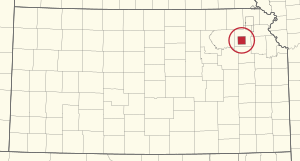Prairie Band Potawatomi Nation facts for kids
| Mshkodéniwek | |
|---|---|

Prairie Band Potawatomi Nation Flag
|
|
| Total population | |
| 4,617 (2018) | |
| Regions with significant populations | |
| United States (Kansas) | |
| Languages | |
| Potawatomi, English |
The Prairie Band Potawatomi Nation, also known as Mshkodéniwek in their own language, is a Native American tribe. They are part of the larger Potawatomi people, who are called Neshnabé. This tribe is officially recognized by the United States government. Their main offices are located near Mayetta, Kansas.
Contents
A Look Back: The Potawatomi Story
Where the Potawatomi Lived First
The Mshkodésik, which means "People of the Small Prairie," were a group within the Potawatomi tribe. They originally lived near the southern part of Lake Michigan. This area is now southern Wisconsin, northern Illinois, and northwestern Indiana. Because of their name, the Mshkodésik were sometimes confused with another tribe called the Mascoutens.
The Prairie Band was part of a group of tribes known as the Council of Three Fires. They signed an important agreement in 1829 called the Second Treaty of Prairie du Chien. They also signed another agreement in 1832, the Treaty of Tippecanoe. In this agreement, they were called the "Potawatomi Tribe of Indians of the Prairie."
Moving West: A Difficult Journey
In the 1830s, Chief Shab-eh-nay was a leader of tribal members living on land in Illinois. He went to visit family members who had been forced to move west to Kansas. While he was away, the United States government took his people's land. They sold it to others.
Under a law called the Indian Removal Act, the Prairie Band was forced to move west. First, they moved to Platte County in Missouri in the mid-1830s. Then, in the 1840s, they moved near Council Bluffs, Iowa. Here, they were known as the "Bluff Indians." In these places, the tribe controlled a very large amount of land, up to five million acres. After 1846, the tribe moved to what is now Kansas. Their reservation at that time was about thirty square miles. It even included part of what is now Topeka.
Fighting for Their Rights: The Termination Policy
From the 1940s to the 1960s, the U.S. government had a plan called the Indian termination policy. This policy aimed to end the special relationship between tribes and the federal government. Four tribes in Kansas, including the Potawatomi, were chosen for this policy.
One of the first laws passed during this time was the Kansas Act of 1940. This law changed who had power over crimes involving Native Americans. Before, only the federal government handled these cases. Now, the state of Kansas could also get involved.
On August 1, 1953, the U.S. Congress passed a resolution called House Concurrent Resolution 108. This resolution called for several tribes to be "terminated" right away. This meant they would lose all federal help, services, and protection. Their reservations would also end. A government memo later made it clear that "Potawatomi" in this resolution meant the Prairie Band of Potawatomi Nation. It also included the Kickapoo, Sac and Fox, and Iowa tribes in Kansas.
Because Kansas already had power over criminal matters, the government wanted to terminate these four Kansas tribes quickly. Meetings were held in February 1954 to discuss this.
A Leader Stands Up
Minnie Evans, a leader of the Prairie Band of Potawatomi Nation, worked hard to stop the termination. Her Indian name was Ke-what-no-quah Wish-Ken-O. Tribal members sent many letters of protest to the government. Several groups went to Washington, D.C., to speak at congressional meetings. Tribal Council members Vestana Cadue, Oliver Kahbeah, and Ralph Simon from the Kickapoo Tribe in Kansas also traveled to speak, paying their own way. The strong opposition from the Potawatomi and Kickapoo tribes helped them. It also helped the Sac & Fox and the Iowa Tribe avoid termination.
Building for the Future
In May 1997, the Prairie Band Potawatomi Nation started building the Prairie Band Casino & Resort. They wanted to create money for the tribe. The casino opened on January 12, 1998. At first, an outside company managed it. But in July 2007, the tribe took over managing the casino themselves.
In 2006, the tribe bought back a small part of their original land in DeKalb County, Illinois. They leased this land for farming. In 2024, the United States Department of the Interior officially put these 130 acres into a special trust for the tribe. This means the Prairie Band now has tribal sovereignty, or self-rule, over this land. The Prairie Band Potawatomi became the first and only federally recognized tribal nation in Illinois since Native Americans lost their lands in the 1800s.
Notable People
Here are some important people from the Prairie Band Potawatomi Nation:
- Charles J. Chaput: He was the first Native American archbishop in the Catholic Church.
- Venida Chenault: She is the president of Haskell Indian Nations University, a special university for Native American students.
- Curtis J. Keltner: He was a Green Beret and a veteran of the Iraq War.
- Jessica Rickert: She was the first Native American woman to become a dentist in America. She graduated from the University of Michigan School of Dentistry in 1975. She was a direct descendant of the Indian chief Wahbememe (Whitepigeon).
- Shabbona: He was an important warrior and chief in Illinois during the 1800s.
- Stephanie "Pyet" DeSpain: She was the winner of the first season of the TV cooking show Next Level Chef.


